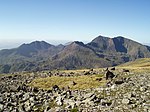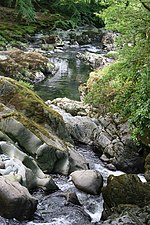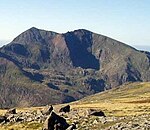Rocky Valley Halt railway station

Rocky Valley Halt is an intermediate station on the Snowdon Mountain Railway. It consists of a narrow platform sheltered by the rocky outcrop of Llechog to the east. Immediately beyond the platform the line joins the exposed ridge on which it runs for about half a mile. The line starts in the valley bottom at Llanberis at an altitude of 353 ft (108 m), Rocky Valley Halt stands at 2,330 ft (710 m).The summit station stands at 3,493 feet (1,065 m), 68 feet (21 metres) below the summit of the mountain. The halt is a later addition to the line, opening after the Second World War. Trains do not normally stop at the halt, but may terminate there if Clogwyn and the summit are considered too windy. The station has one platform.
Excerpt from the Wikipedia article Rocky Valley Halt railway station (License: CC BY-SA 3.0, Authors, Images).Rocky Valley Halt railway station
Llanberis Path,
Geographical coordinates (GPS) Address External links Nearby Places Show on map
Geographical coordinates (GPS)
| Latitude | Longitude |
|---|---|
| N 53.0889 ° | E -4.0838 ° |
Address
Rocky Valley Halt
Llanberis Path
LL55 4UL , Llanberis
Wales, United Kingdom
Open on Google Maps










